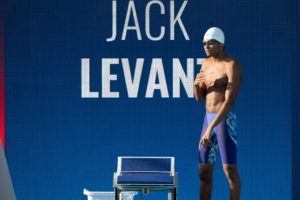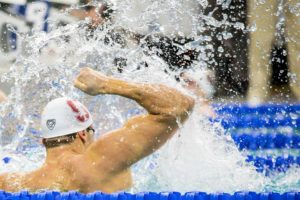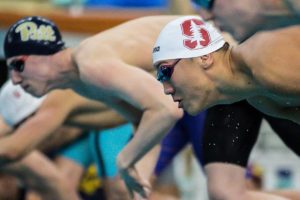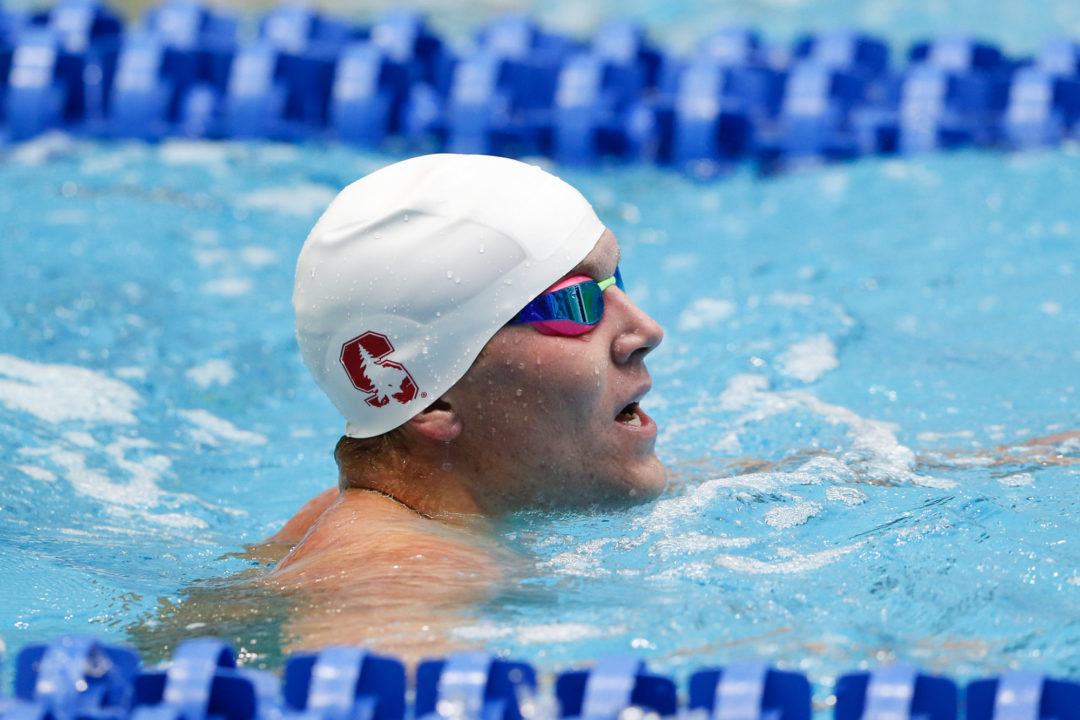We’ll be previewing the top 12 men’s and women’s programs for the 2019-2020 season – stay tuned to our College Swimming Previews channel to catch all 24. Can’t get enough college swimming news? Check out the College Preview issue of SwimSwam Magazine for more in-depth college swimming coverage, including a bird’s-eye view of the flood of coaching changes and our ever-popular rankings of the top 50 individual swimmers in college swimming.
#9 Stanford Cardinal
Key Losses: Abrahm Devine (34 points, 4 NCAA relays), Brad Zdroik (3 NCAA relay), Patrick Conaton (3 NCAA relay), Cole Cogswell (2 NCAA relay), Matt Anderson (2 NCAA relay)
Key Additions: Shane Blinkman (WI – breast/IM), Will Tarvestad (KY – sprint free), Andrew Matejka (MA – distance), Leon Macalister (Australia – free), Neel Roy (India – free), Sean Slusiewicz (CA – fly/free/breast), Ethan Foster (NC – diving)
GRADING CRITERIA
We’re unveiling a new, more data-based grading criteria in this year’s series. Our grades this year are based on ‘projected returning points’, a stat of our own making. We started with our already-compiled “no senior returning points” (see here and here), which is effectively a rescoring of 2019 NCAAs with seniors removed and underclassmen moved up to fill those gaps. In addition, we manually filtered out points from known redshirts and swimmers turning pro early, while manually adjusting points for outgoing and incoming transfers and adding in projected points for incoming freshmen with NCAA scoring times, as well as athletes returning from injury or redshirts who are very likely NCAA scorers.
Since we only profile the top 12 teams in this format, our grades are designed with that range in mind. In the grand scheme of college swimming and compared to all other college programs, top 12 NCAA programs would pretty much all grade well across the board. But in the interest of making these previews informative, our grading scale is tough – designed to show the tiers between the good stroke groups, the great ones, and the 2015 Texas men’s fly group types.
- 5 star (★★★★★) – a rare, elite NCAA group projected to score 25+ points per event
- 4 star (★★★★) – a very, very good NCAA group projected to score 15-24 points per event
- 3 star (★★★) – a good NCAA group projected to score 5-14 points per event
- 2 star (★★) – a solid NCAA group projected to score 1-4 points per event
- 1 star (★) – an NCAA group that is projected to score no points per event, though that doesn’t mean it’s without potential scorers – they’ll just need to leapfrog some swimmers ahead of them to do it
We’ll grade each event discipline: sprint free (which we define to include all the relay-distance freestyle events, so 50, 100 and 200), distance free, IM, breaststroke, backstroke, butterfly and diving. Bear in mind that our grades and painstaking scoring formula attempts to take into account all factors, but is still unable to perfectly predict the future. Use these grades as a jumping-off point for discussion, rather than a reason to be angry.
2018-2019 LOOKBACK
It was a year of bad breaks for the Stanford men, who opened the year at #4 in our power ranks with most of their scorers returning and incoming freshman Jack Levant coming off a breakout summer. But star distance swimmer Grant Shoults missed the fall with an injury, then had shoulder surgery and ultimately didn’t return until summer. Levant bowed out of NCAAs for undisclosed reasons, later revealed to be related to mental health.
With those two gone and star sprinter Alberto Mestre also absent for undisclosed reasons, it was a skeleton crew that ultimately made the trip to NCAAs for the Cardinal. Stanford slipped from 7th to 15th, scoring less than half the points they did in 2018 (96 compared to 205).
2019-2020 will be another season of change, as longtime coach Ted Knapp stepped down. With new head coach Dan Schemmel, Stanford will rely on last year’s absentees to return at full force if they hope to move back into the top 10.
Sprint Free: ★
The sprints were absolutely brutal for Stanford last year, with zero NCAA individual swims. Luckily, reinforcements should be coming from all directions.
Alberto Mestre remains on the roster and should be in line to return to competition this year after a good summer representing Venezuela internationally. The 6-foot-8 junior went 19.5 and 43.5 in the sprints as a freshman, and hit a lifetime-best 49.7 in the 100-meter free this summer. He was also 22.4 in the 50, a tenth off his best. Mestre had a 19.0 split at NCAAs in his rookie year, and should be a huge boost to the free relays in his junior return.

Jack Levant (photo: Mike Lewis)
Both Jack Levant and Grant Shoults are potential scorers in the 200, though it’s hard to pinpoint exactly what we should expect from them. Levant’s 1:32.6 from the middle of last season would be in line to score big points – it would have been 13th at NCAAs last year and half the men ahead of him graduate. On the other hand, when Levant did return to competition last summer, his best meters time was 1:50.6, a good four seconds from his career-best.
Same goes for Shoults, who was about three and a half seconds off his best (1:47.8) in his return to competition last summer (1:51.3). Both have the potential to score, but it’s probably not a safe bet to pencil them in as scorers until we see them compete for more information on how recovery is going.
The flip side is that the recruiting class is very strong in the sprints. Will Tarvestad out of Kentucky is 19.9 in the 50 and is a huge boost to a team that graduated all four of its sub-20 swimmers from last year. Tarvestad is also 44.1 in the 100. The Cardinal got Sean Slusiewicz (20.3/44.6) out of California, and adds two solid internationals: Australia’s Leon MacAlister (23.3/50.6 in long course, converting roughly to 20.3/44.3) and India’s Neel Roy (23.4/51.4, converting roughly to 20.3/44.9).
None of that group are likely individual scorers. But they do provide a foundation to build on for future years, and should help restock the sprint free relays, which graduated 6 of 8 combined legs from last year.
Sophomore Mason Gonzalez is a key returner. He was 20.0, 43.5 and 1:34.5 individually in the 100 last year and swam solid legs on all three free relays at NCAAs. (He split 19.4, 43.2 and 1:34.6, all from flying starts). He’ll be even more impactful if he can return to his high school best of 43.0 in the 100 free.
Also returning is junior Jordan Greenberg (20.01 last year), junior Alex Liang (43.8), senior James Murphy (1:34.4), junior Will MacMillan (1:34.5) and senior Hank Poppe (20.1), who could all be fringe relay guys.
Distance Free: ★★★★

True Sweetser (photo: Jack Spitser)
Distance is the strength of this team, projected to score 35 points event without Shoults and Levant. True Sweetser scored a dozen last year as a junior, and returns as the 4th overall miler at 14:39.07. The Cardinal also returns last year’s 9th-placer Johannes Calloni (14:40.53 as a sophomore).
In the 500, Calloni (21st last year) is projected to move into scoring range with his 4:15.58. Sweetser had a bad swim at NCAAs, but his season-best of 4:15.21 would also be near scoring range. The depth here is great: senior James Murphy (4:15.2/14:44.0) and junior Matthew Hirschberger (4:15.5/14:54.6) are both outside-shot scorers.
If Shoults can be expected to return to his lifetime-best (4:10.0) from 2018, he could win the 500 this year. But again, he was about six seconds off his lifetime-best in the 400 meters this summer, so it’s hard to say how well he’s back from surgery. Levant could also score: his midseason 4:13.11 was the team’s best 500 all year.
Further back, the Cardinal picked up top-level distance recruit Andrew Matejka (4:21.6/15:17) who probably isn’t an immediate scorer without a huge freshman year, but who should be a great prospect for Schemmel to work with.
Backstroke: ★
The backstrokes are thin, with three of the top four 100 guys graduating. Stanford returns just one backstroke swim from 2019 NCAAs: a 30th-place showing in the 200 back from Calloni.
Junior Glen Cowand is the top returner at 1:41.6 in the 200 and 46.7 in the 100 – not far off of NCAA invite range in both. Cowand had a great sophomore season, too, dropping from 1:43.8 and 47.3, respectively.
In the 100, senior Benjamin Ho is actually the top returner at 46.4, and he and Cowand should battle for the medley relay post. In addition, Australian freshman Leon MacAlister is 55.7 in long course, converting roughly to 47.4. Mostly, though, Stanford is just trying to stay afloat in backstroke, without huge point-scoring prospects.
Breaststroke: ★★★

Hank Poppe (photo: Jack Spitser)
Stanford had two breaststroke scorers and two more invitees last year, and three of the four return. Hank Poppe was the top sprinter at 51.9, winning the NCAA B final and looking like a potential A finalist in his senior season. He was also 1:53.8 and 17th in the 200 breast, and should score there this year with even a small improvement.
Freshman Daniel Roy is much more of a 200 specialist, and wound up 12th (1:52.9) in the 200. Poppe and Roy have a chance to both swim in next year’s A final.
Stanford also returns Brennan Pastorek, a sophomore NCAA qualifier last year. He’s on the cusp of scoring range in the 100 (52.8) and maybe in better shape in the 200 (1:53.3), though he had a bad swim at NCAAs in the latter last year.
Making things even better, arguably Stanford’s top recruit is breaststroker/IMer Shane Blinkman out of Wisconsin. Blinkman is 53.7 and 2:00.9 out of high school and joins a loaded training group. Even when Poppe graduates, a Roy/Pastorek/Blinkman trio is awfully tough to beat in the breaststrokes.
Butterfly: ★★
The butterflys are closer to the backstrokes, with low projected scoring totals based on returners. Alex Liang (1:42.7 as a sophomore) is projected to score a couple “no senior” points in the 200 after finishing 25th last year, but he’ll also probably have to drop some time to do it.
The 200 should be the stronger of the two fly events. Levant is an elite 200-meter flyer, having gone 1:55.8 last summer. But his short course best is 1:43.4 (more than a second from last year’s invite time) and he was just 2:02 in his only 200-meter fly swim last summer. So points are difficult to project here until we see a healthy Levant back in action.
Sophomore David Madej is the top returning sprint flyer, with Brad Zdroik graduated. He was 47.40 last year, just barely edging out his high school best of 47.48. Junior Will MacMillan (47.6/1:44.4) might be the best two-distance guy, though his 200 actually went backwards from his freshman to sophomore years.
Maybe the chief threat to both of them for a medley relay role is incoming freshman Sean Slusiewicz, who is 47.1 out of high school.
IM: ★★★

Alex Liang (photo: Jack Spitser)
The IMs are still very solid, even with NCAA champ Abrahm Devine graduating. Alex Liang was a B finalist in the 400 IM last year (3:42.1) and projects to move into the A final next year with four of eight graduating from that heat.
In the 200, Stanford has a bunch of guys on the cusp of NCAA invite status: Liang and Pastorek were both 1:44.0s last year (it took 1:43.8 to get invited and 1:43.0 to score), and Ho was 1:44.5. Toss in the freshman Blinkman (1:45.7 out of high school in an event discipline where we tend to see big drops throughout college) and rising junior MacMillan (1:45.1 at Pac-12s) and there are a bunch of guys primed to make an NCAA splash, albeit in small points unless they really take off this season.
Diving: ★★★
Diving should be a huge boost to Stanford. Freshman Noah Vigran scored 14 points last year and has a real shot to score on all three boards as a sophomore. He’s joined by fellow sophomore Conor Casey, who made NCAAs on both springboards and projects to score on 1-meter with seniors factored out.
Incoming freshman Ethan Foster also looks like a solid pickup after taking second at North Carolina 4A state.
Relays
The relays look particularly brutal to rebuild, with only 6 of 20 relay legs from 2019 returning. But things aren’t as bleak as they seem. Only two of those five relays scored last year, and those two were both 15th. So it’s not like a huge amount of points are walking out the door on relays, though Stanford will need to reload big-time just to score any relay points in 2020.
The medleys are interesting. On the breaststroke leg, Poppe was actually faster than graduated Matt Anderson in the 100, so those legs could turn out to be an upgrade. Three of the top four backstrokers are gone, but Conaton was just 46.6 at NCAAs and Ho went 46.4 individually at NCAAs. Consider that one about a wash. Fly is where the big hurt might come, with Zdroik a good second faster than anyone on the roster last year. Levant is the high-upside choice, but he’s a major question mark, and not a true sprinter even when he’s healthy. Freestyle should turn out OK, with Gonzalez or Mestre likely taking over for Zdroik (18.9) or Devine (42.0).
Consider both medley relays outside B final types, unless someone steps up in a big way.
The 200 free relay actually did score last year, but loses three of four legs. Gonzalez remains a solid leg, and Mestre will be big if he’s back in action. The rest of the relay is some combo of Tarvestad (19.9), Greenberg (20.0), Poppe (20.1), Slusiewicz (20.3) or one of the internationals, MacAlister or Roy. Same goes for the 400, where it’s probably Gonzalez and Mestre pairing with two of Liang (43.8), Levant (44.5 last year but 43.9 out of high school), Tarvestad (44.1), Slusiewicz (44.6), MacAlister or Roy. Depth isn’t an issue, but you need mostly 19-lows and 42s/43s to score at NCAAs, so Stanford has its work cut out for it.
The 800 should be Stanford’s best relay. Murphy split 1:33.5 last year and Gonzalez 1:34.2, plus Liang went 1:34.4. Throw in either or both of Shoults (1:33.2 on this relay as a sophomore) and Levant (1:32.6 individually last year) and this has the makings of a borderline top-8 relay.
2019-2020 Outlook

Dan Schemmel (photo: Jack Spitser)
For Stanford, much is riding on their trio of projected returners. Mestre seems like the safest bet – he swam very well this summer, and the only real worry is that he takes an Olympic redshirt. Levant and Shoults are a little iffier: they were at least back to competing late this summer, but are total question marks heading into the 2020 season. They could be anwhere from 20+ point individual scorers to complete non-factors. But Stanford probably can’t take another year without those two and remain in the top 10.
The distance and breaststroke groups look top-notch, and diving and IM should also be solid point hauls. (The distance groups are especially exciting given new head coach Schemmel’s successes with distance swimmer Phoebe Hines in his time at Hawaii). The relative weaknesses in fly, back and sprint free, though, threaten to keep the relay points really low. And that’s a tough thing for an NCAA team to overcome.
The individual points should be there for Stanford, with or without Levant, Shoults and Mestre. But those three could singlehandedly transform the relays. And that’s what’s going to determine whether Stanford is a top 20 team or a top 10 one.

Agree that Levant and Shoults will rebound back to form, I think Blinkman will be solid as a freshman and D Roy will have a great sophomore year. Lack of sprint free depth is really crushing in NCAA format though.
The new coaching situation is also a big question mark. There are too many unknowns for the cardinal, and they could could easily over- or underperform by a large amount.
Levant was 1:47.5 on his relay split at Worlds, so that’s a little more encouraging than his flat start. I’ll think he’ll round into form by midseason taper at the latest.
Look for Will Macmillan to fill in for Zdroik on the medley relays. He has been doing no swimming and exclusively deadlifting all summer in preparation for an absolutely devastating first 25. With this heavyweight carrying Stanford’s relays, you really can’t not be feeling Stanford being back in the top five this year
At the start of this comment I was doubtful, but it be how it do. You really can’t not be feeling this
I wouldn’t be surprised to see Shoults / Levant come down in yardage this year to stay healthy. Besides, Stanford is still stacked in the distance.